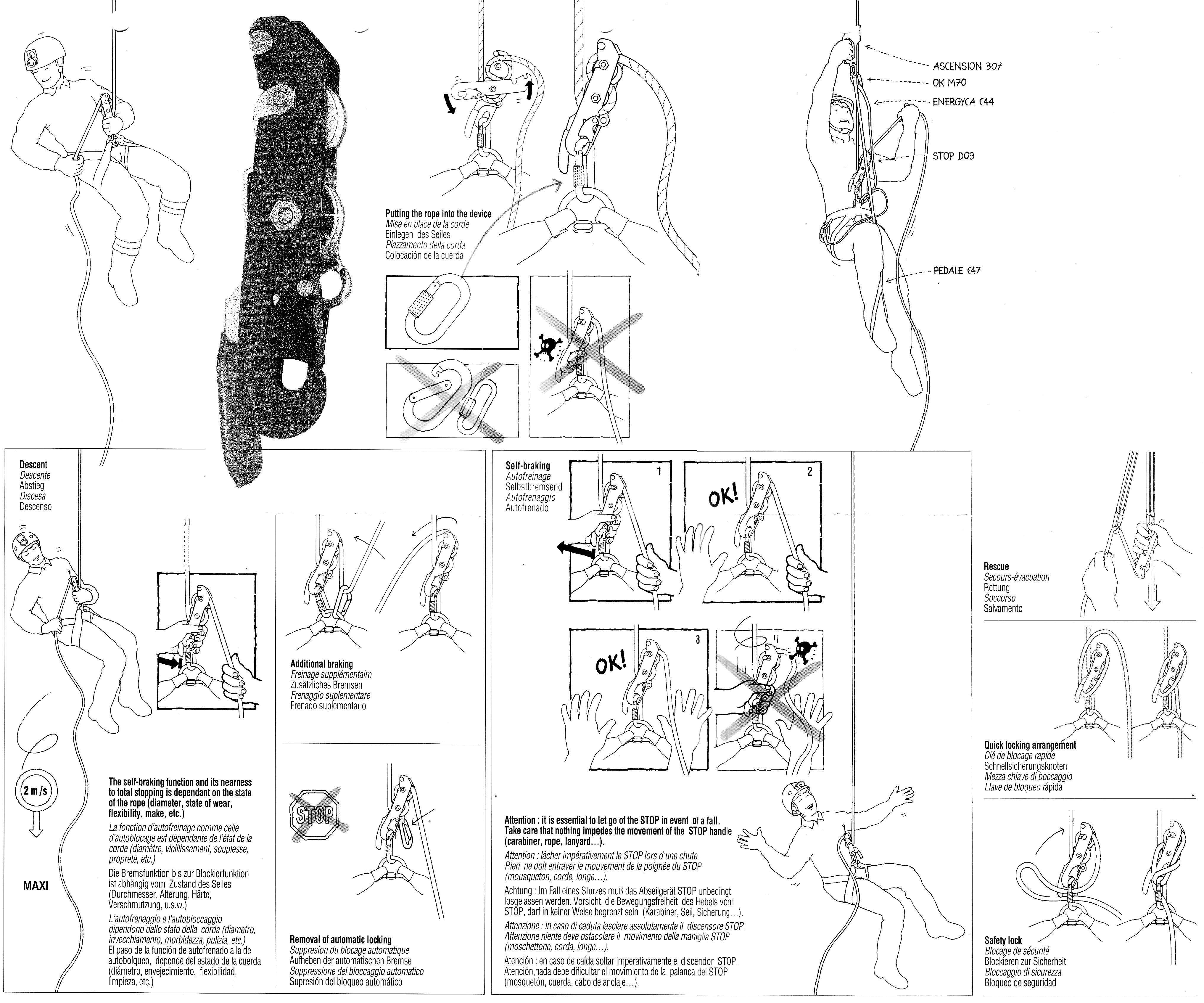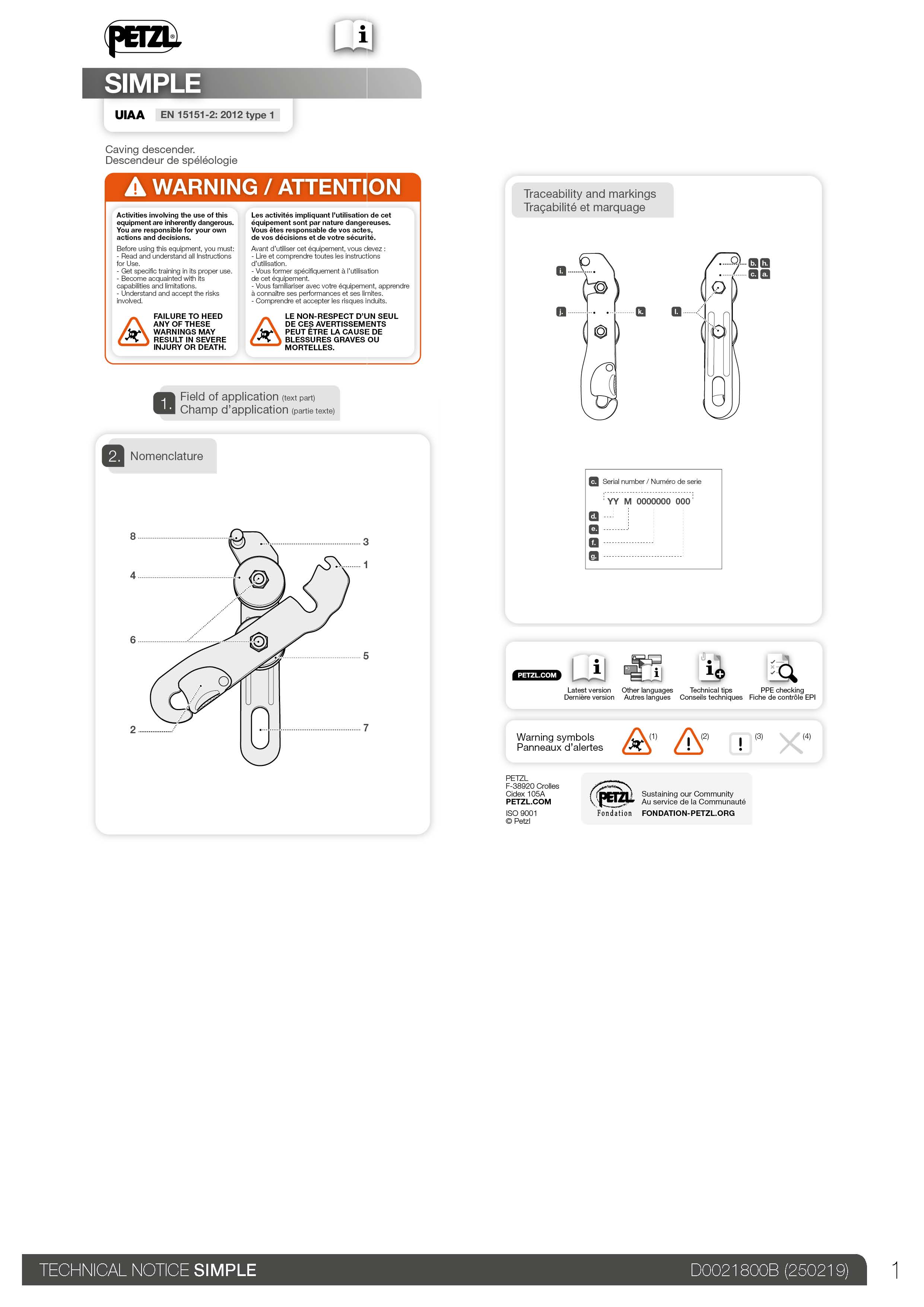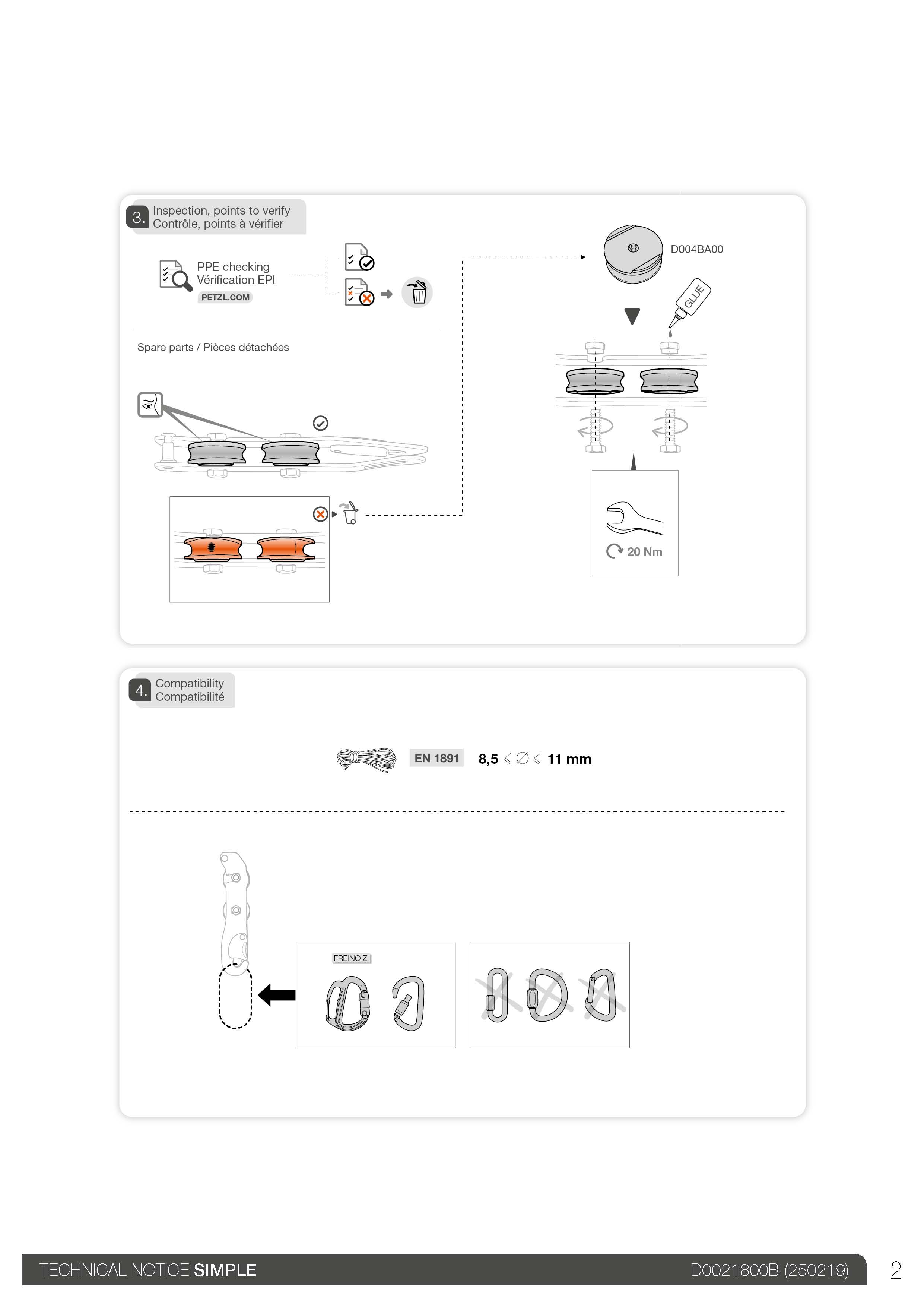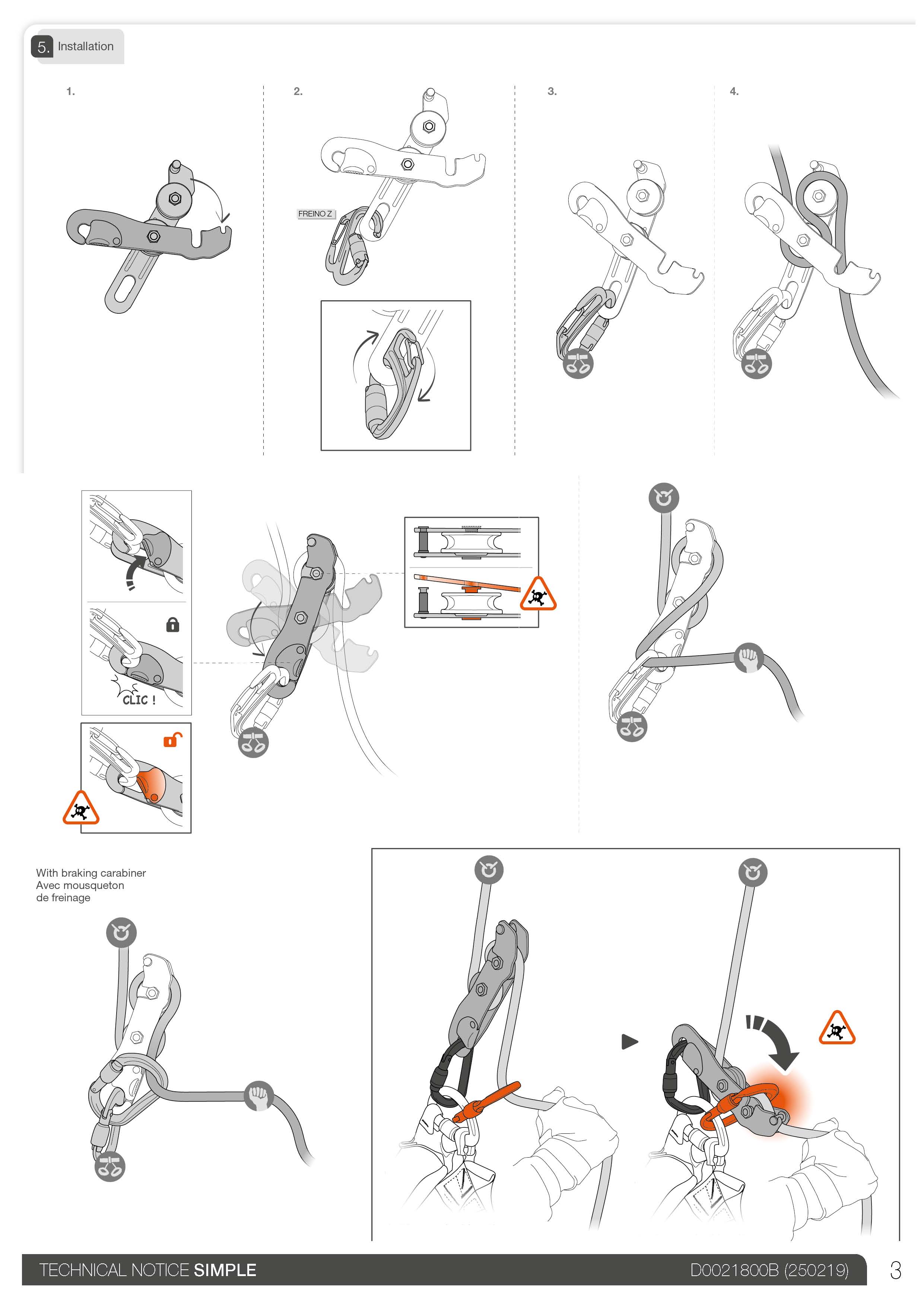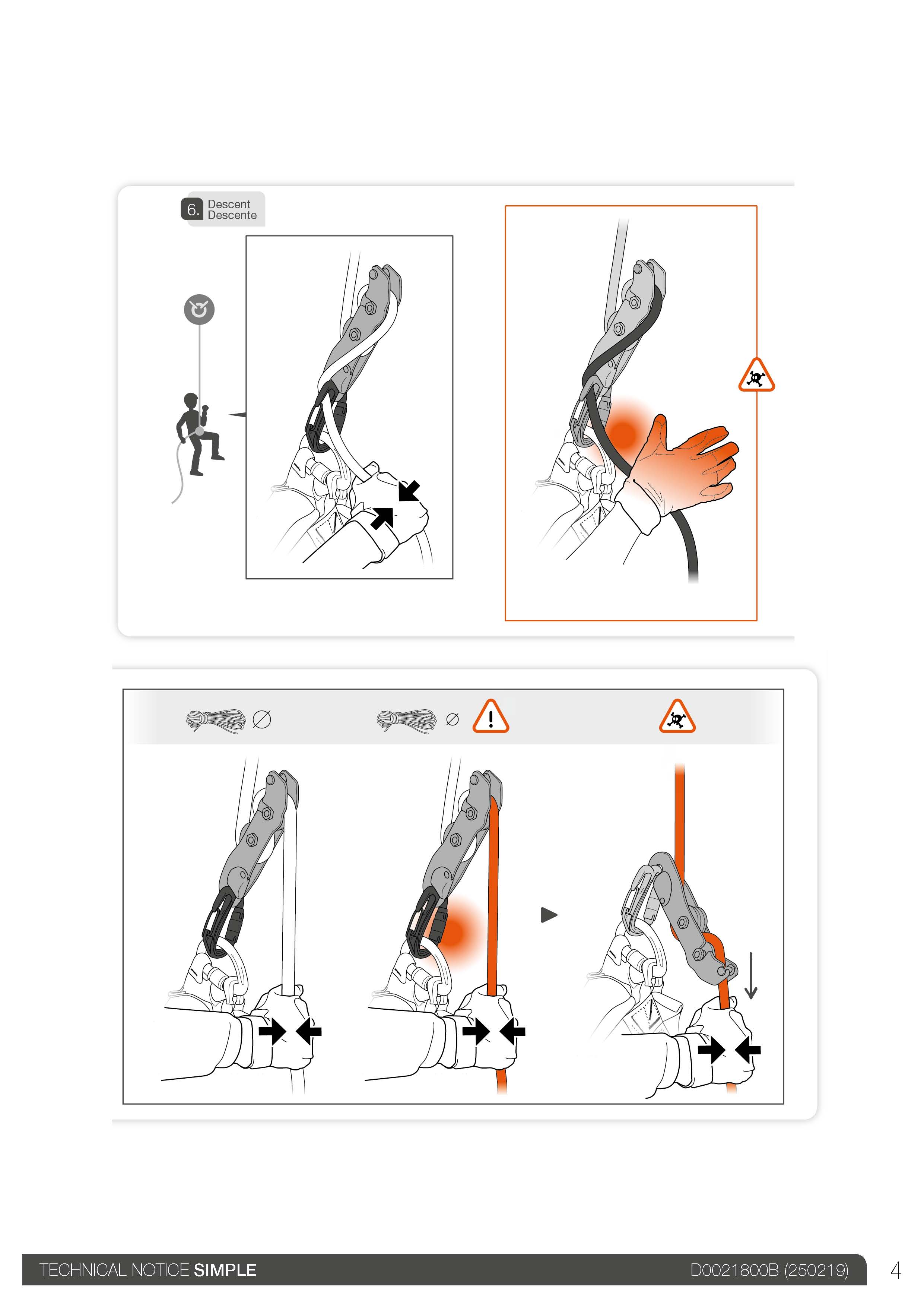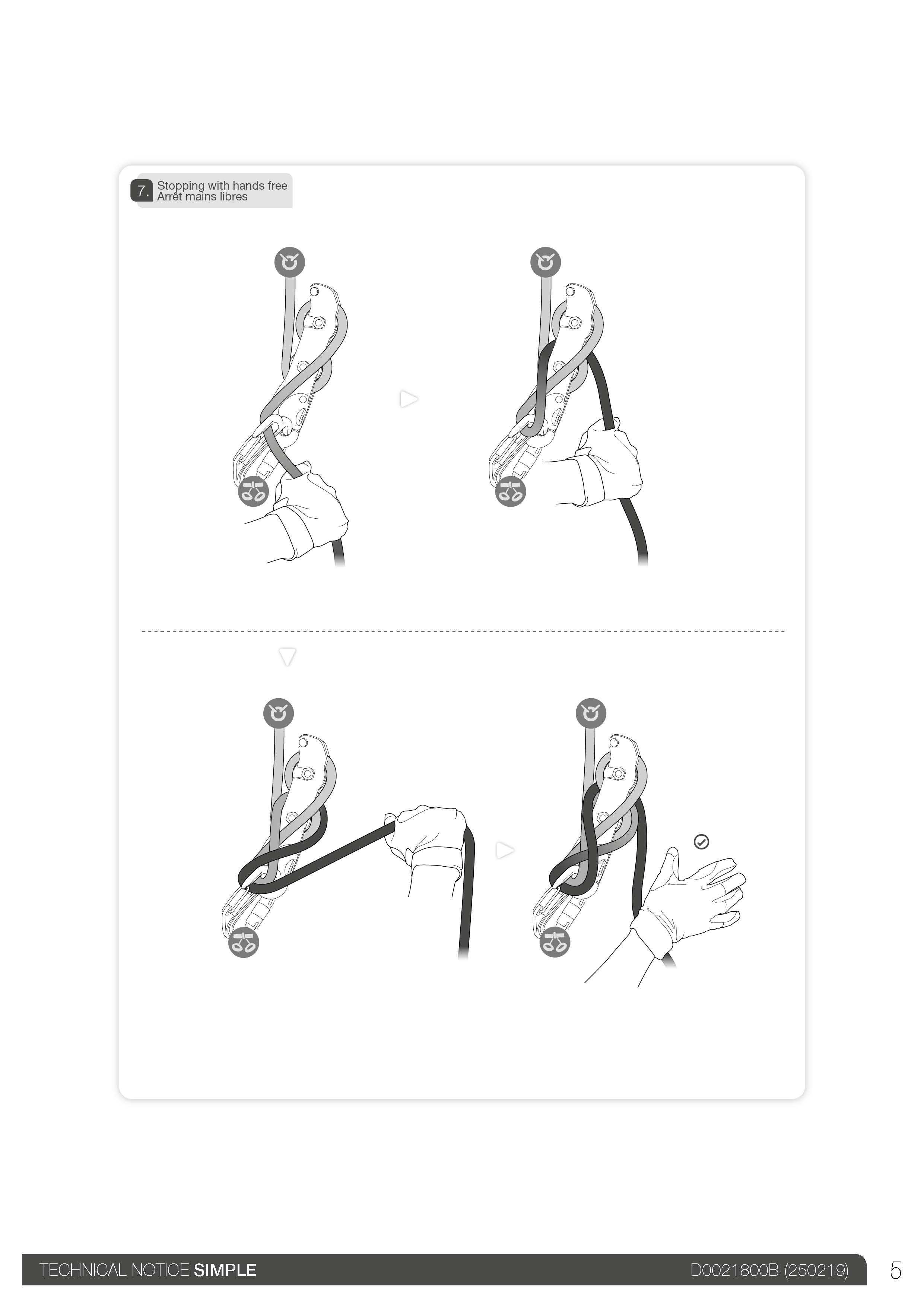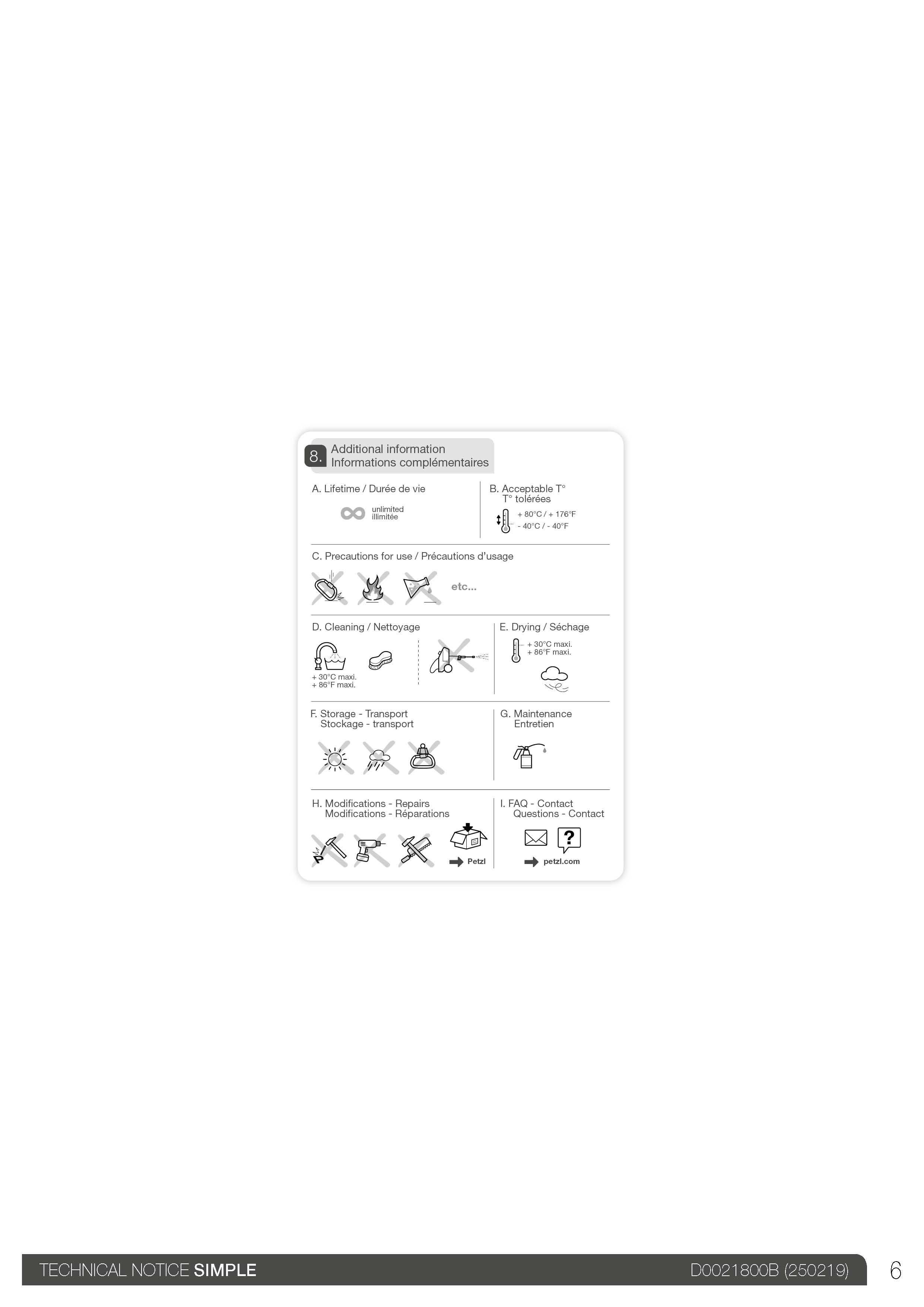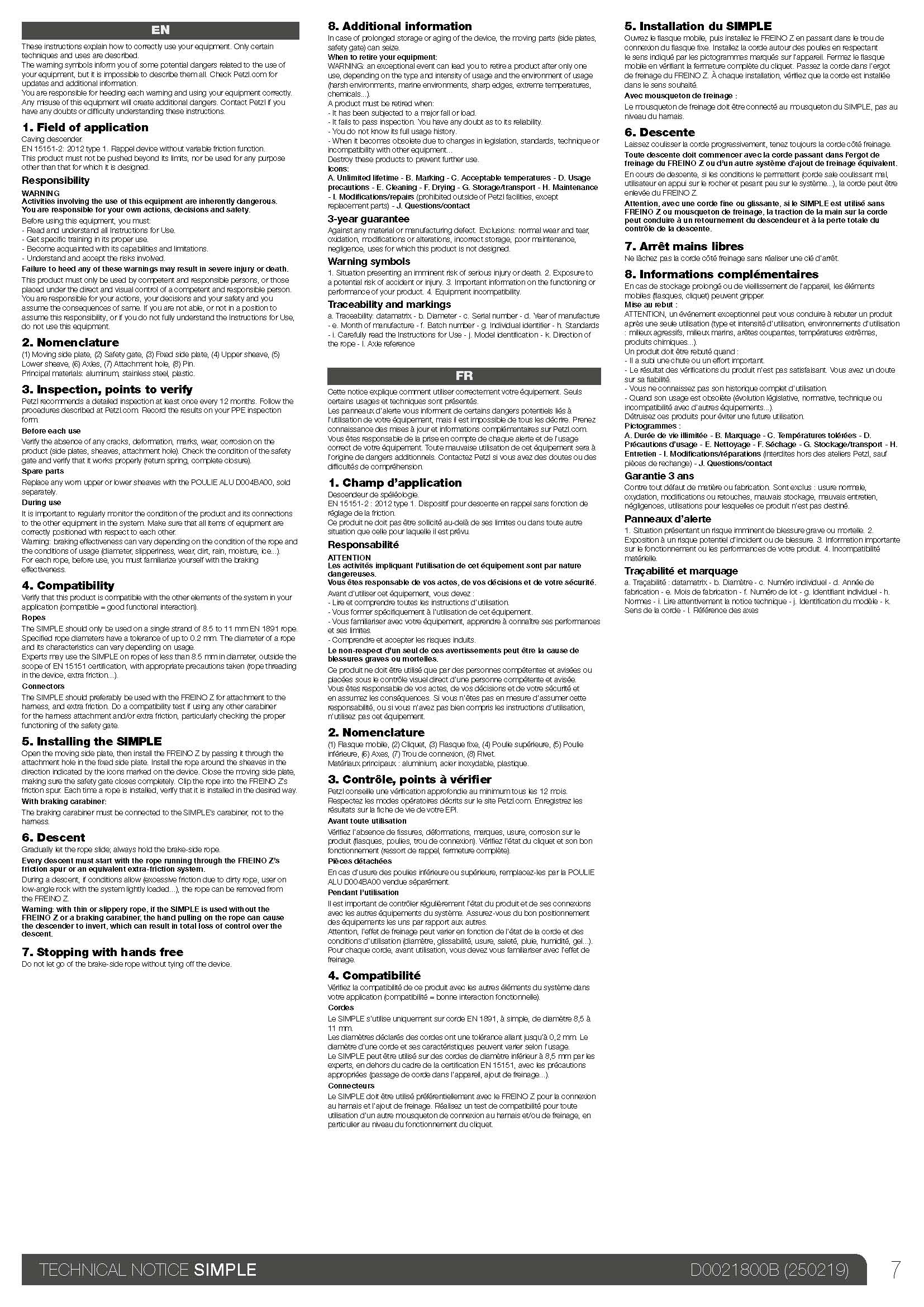Overview
The Petzl Stop is one of the world's most popular descenders.
Its light weight and small size contribute to its popularity, as does the European preference for everyone using the same system. Here is a quick summary of the versions in my collection:
- Narrow frame
(#435)
- Wider pivoting plate
(#436)
- Red slip-on handle
(#1324)
- Revised lower bollard steel insert, notched fixed plate
(#2420)
- Cast steel lower bollard, auxiliary rod replacing upper frame bend
(#437)
- Reinforcing bends on fixed plate
(#2586, 3141)
- Ribs added to lower bollard, ridges added to red handle cover
(#438, 3020)
- Pivoting plate opening stop, reinforced hook
(#3160)
- Narrower pivoting plate, plastic gate
(#541)
- EN 341 stamp
(#3026)
- Complete redesign, inverting the operation
(#2526)
[ Top
| Version B
| Version C
| Version D
| Version E
| Version F
| Version G
| Version H
| Version I
| Version J
| Version K
| Return to Bobbins
]
Version A
(#435)
Technical Details
I acquired this descender from Repetto Sport in Genova, Italy
in 1982.
This version is 225 mm. tall, 61 mm. wide, 33 mm. thick, and weighs 289 g.
The side plates are black anodized aluminum similar to those
in the single rope Petzl Version B.
This bobbin also has a similar quick attach feature.
The lower bollard is part of an autostop assembly. The upper surface of the bollard is milled flat and a J-shaped piece of 3 mm. steel is inset and screwed to the bollard. This protrudes at the 10 o'clock position and acts as a cam much like the cylinder attached to the Diablo. A aluminum handle is riveted to the fixed side plate side of the lower bollard. The handle portion is bent into a U to increase thickness for comfort. The lower bollard and handle assembly rotate on a shoulder nut on the lower bolt. A concealed spring tries to keep the handle in the disengaged position, but is weak enough to function only during storage. Friction from the main rope's passage tends to turn the lower bollard and force the toothed cylinder towards the upper bollard, thus locking the rope and ideally arresting the descent. The rappeller uses the handle to keep the autostop feature disengaged. Alternately, a hole in the handle plate opposite the handle itself allows one to clip a carabiner in, thus disabling the autostop feature by preventing rotation of the lower bollard assembly. A small cutout in the fixed side plate provides clearance for this carabiner.
The upper bollard is cut away on its lower side to provide
a flat surface to act as an anvil for the cam action of the autostop
feature. A rounded 10 mm. steel cylinder is pressed into
a hole in the lower surface of this bollard, and acts as a wear
resisting bar.
The pivoting side plate is stamped with a rigging illustration, "STOP,"
"BREVETE," "FRANCE_Etranger," the Petzl logo, "MAXI 1500 KG," and "FRANCE." The bolt heads
are marked "A2" twice.
Paul and Pierre Petzl developed the Stop and applied for a patent in March 1979. They received French Patent #2,451,752 the following year.
This bobbin was one of the descenders in my normal caving set,
so I have used it extensively in a wide variety of conditions.
Unlike most autostop bobbins, the Petzl design works well, perhaps
due to the flat cutout on the bottom of the upper bollard. I prefer
this bobbin over any other autostop descender (bobbin or other)
in my collection. Despite this, one must realize that the availability
of an autostop feature may encourage one to rely on it. Since
the required action in an emergency situation is letting go of
the descender, the autostop feature should never be relied on.
See my 1995 internet
post on rappel safeties for more information.
The handle spring is a nice idea. Its only function is to keep
the handle from flopping around inside one's pack. It is far to
weak to have any adverse effect while on rappel. Petzl does not
use a bronze bollard bushing like in the Diablo,
and I have never missed having one. All in all, I feel that this
device is very well made, and aside from its inability to function
on doubled ropes, it has served me very well.
[ Top
| Version A
| Version C
| Version D
| Version E
| Version F
| Version G
| Version H
| Version I
| Version J
| Version K
| Return to Bobbins
]
Version B
(#436)
Technical Details
I acquired this descender from Caves Unlimited in 1984.
This version is 226 mm. tall, 64 mm. wide, 32 mm. thick, and weighs 302 g.
It differs from Stop Version A in the pivoting side
plates and bolts only. The pivoting side plate has been made about
6 mm. wider in the area of the upper bollard nut clearance notch
and approximately 8 mm. wider in the quick-attachment area.
Both side plates are blue anodized.
The pivoting side plate is stamped with a rigging illustration, "STOP,"
"BREVETE," "FRANCE_Etranger," the Petzl logo, and "FRANCE." The
bolts are marked with "A2" and an "L" inside
a diamond.
Performance is identical to Version A's. The beefed
up side plate may increase strength, but I doubt that anything
is wrong with the strength of Version A, so I consider the
extra weight superfluous. The use of a different lot of bolts
is unimportant. I almost never use this bobbin since I see no
advantage over Version A.
People who are into strength ratings of vertical gear should
read the descriptions of the side plate markings for Versions
A and C. I am not sure if Version B is really any
weaker than Versions
A. If it is, then the change was for
the worse. On the other hand, if the older Stops are not stronger,
then why did Petzl claim they were? If there is a legitimate explanation
for the differences, I would like to hear it.
[ Top
| Version A
| Version B
| Version D
| Version E
| Version F
| Version G
| Version H
| Version I
| Version J
| Version K
| Return to Bobbins
]
Version C
(#1324)
Technical Details
I acquired this version from Geoffrey Storey in 2012.
This version is 231 mm. tall, 63 mm. wide, 32 mm. thick, and weighs 297 g.
This bobbin functions on the same principles as the previous Stop models, so I'll keep the description brief. The major
differences between Versions B and C is that the handle on Version C has a loose fitting red plastic cover.
The markings on Version C are the same as those on Version B. The pivoting side plate is stamped with a rigging illustration, "STOP,"
"BREVETE," "FRANCE_Etranger," the Petzl logo, and "FRANCE." The
bolts are marked with "A2" and an "L" inside
a diamond.
The red slip-on plastic handle looks pretty,
but serves no useful purpose except perhaps in extreme cold. It tends to get chewed up after a few exposures to the harsh cave
environment. I never missed not having one on Version A.
[ Top
| Version A
| Version B
| Version C
| Version E
| Version F
| Version G
| Version H
| Version I
| Version J
| Version K
| Return to Bobbins
]
Version D
(#2420)
Technical Details
I acquired my Petzl Stop, Version D in 2017 as part of Bob Thrun's collection.
This version is 229 mm. tall, 62 mm. wide, 32 mm. thick, and weighs 309 g.
The major
differences between Versions D and C is the shape of the steel insert on the lower bollard. This piece has an extension that engages a notch cut in the side of the fixed side plate, limiting how far the lower bollard assembly can move toward the "stop" position.
The pivoting side plate is stamped with a rigging illustration, "STOP,"
"BREVETE," "FRANCE_Etranger," the Petzl logo, and "FRANCE." The
bolts are marked with "A2" and an "L" inside
a diamond.
The stop limit provided by the new insert does not accomplish anything in the field, since the rope limits the bollard rotation, as it should. I suspect that it has benefits when overloading the bobbin on a testing machine. Personally, I'd prefer not to have it, and without it, Petzl could eliminate the sharp notch in the rear side plate.
[ Top
| Version A
| Version B
| Version C
| Version D
| Version F
| Version G
| Version H
| Version I
| Version J
| Version K
| Return to Bobbins
]
Version E
(#437)
Technical Details
I acquired this descender from J. E. Weinel Inc. around 1987.
This version is 240 mm. tall, 63 mm. wide, 32 mm. thick, and weighs 327 g.
This bobbin functions on the same principles as the previous
Stop models, so I'll keep the description brief. The major
differences between Versions D and E are as follows:
- This version incorporates a third auxiliary rod similar
Petzl Simple, Version G.
- The lower bollard is now a skeletonized casting, and the
cam is an integral part of the casting.
- The handle is no longer screwed to the lower bollard. It
now fits into a recess in the casting.
- The semi-tubular rivet holding the attachment point guard on now
has the smooth head on the inside next to the rope.
The pivoting side plate is stamped with a rigging illustration, "STOP,"
"BREVETE," "FRANCE_Etranger," "PETZL"
inside an oval, "MAX 750KG," and "FRANCE." The
bolts are marked with "A2" and an "L" inside
a diamond.
For many years, I disliked the redesigned lower bollard.
The skeletonized casting may be lighter, but the shape does not
have nearly the wearing capacity that the machined bollards had.
There is no internal bracing in the casting, and the shape is
undoubtedly weaker than the machined bollards. For these reasons,
a switch to using steel instead of aluminum was necessary. Steel is not as good a thermal conductor as
aluminum. When rappelling too fast, the lower bollard could
overheat, but this has not proven to be a serious problem.
The handle attachment does not appear to be as secure
as the riveted ones, but the design has stood the test of time.
The auxiliary bollard has all the disadvantages
as in the case of the single rope standard
bobbin Version G. In particular, the auxiliary bollard works very well for keeping the rope
on the upper main bollard without binding, but is less satisfactory
when used as part of the braking system. The rod is too small
to function well as a third braking surface, has no means to ensure
that the rope stays on the rod reliably, and is located where
it forces the rope into an inconvenient position. This last point
is particularly noticeable if the trailing rope passes through
a maillon clipped to the seat maillon as indicated in the Petzl
instructions and required for safety. In this case it requires
too many contortions to switch from the two bollard mode to the
three bollard mode.
The weight rating has been reduced from 1500 kg. on the early models to 750 kg. on this one. I do not know the reason, but suspect that it reflects a difference in testing or interpretation rather than an actual weakening of the descender.
All in all, I originally thought this model was a significant step
backwards for Petzl, but my antipathy has diminished.
Petzl Stop descenders are protected by U.S. Patent #5,850,893, which contains drawings
showing a version with the frame of Version B and the
bollards of Version E - but with an extra post below the lower bollard.
[ Top
| Version A
| Version B
| Version C
| Version D
| Version E
| Version G
| Version H
| Version I
| Version J
| Version K
| Return to Bobbins
]
Version F
(#2586, 3171)
Technical Details
I acquired a damaged Petzl Stop, Version F from Seth Parks in 2021, and a used but undamaged one from Gregory Jones in 2022.
Version F is 225 mm. tall, 61 mm. wide, 32 mm. thick, and weighs 325 g.
Petzl folded
the sides of the fixed side plate to make it more resistant to
bending.
The pivoting side plate is stamped with a rigging illustration, "STOP,"
"BREVETE," "FRANCE_Etranger," "PETZL"
inside an oval, "MAX 750KG," and "FRANCE." The
bolts are marked with "A2" and an "L" inside
a diamond.
|
My first Version F bobbin was damaged by a previous owner (not Seth Parks). I knew of the damage when I bought it. The fixed side plate is bent straight where it originally bent inward toward the pivoting plate (see the arrow in the side view above). There is also some distributed bending that has slightly altered the alignment of the two main bollard axles, causing some minor interference when closing the pivoting plate.
This type of damage is typical of loading the bobbin with the pivoting plate open. The photos at the right show what can happen. The Hong Kong Rope Rescue Association found these pictures and posted them on Facebook, along with a video of the incident. The rappeller dropped about ten meters, and appears not to have suffered any serious injury, but it could have been much worse. A caving friend of mine died on a longer drop in a similar incident.
As for my Version F, it looks like the folds in the fixed plate limited the bending and prevented catastrophic frame failure. It would still have been a close call, as there is no guarantee that the rope would not come off the lower bollard if the pivoting plate is open. While the folds are a definite safety improvement, nothing can make rappelling completely safe. |
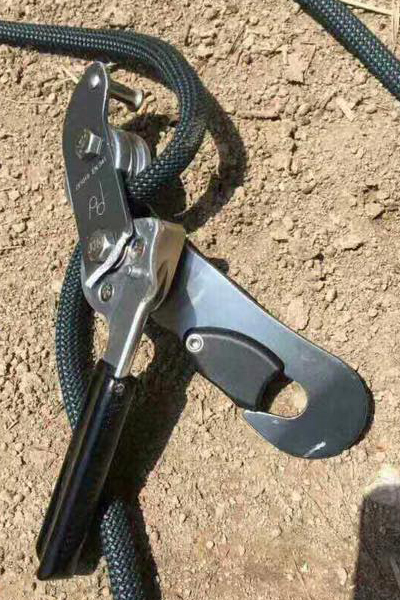 |
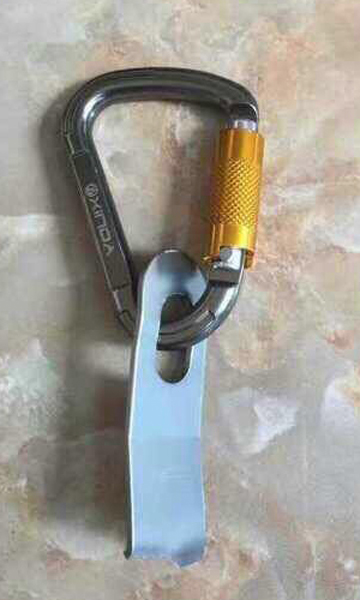 |
| Uncopyrighted photos found on Facebook |
[ Top
| Version A
| Version B
| Version C
| Version D
| Version E
| Version F
| Version H
| Version I
| Version J
| Version K
| Return to Bobbins
]
Version G
(#438, 3020)
Technical Details
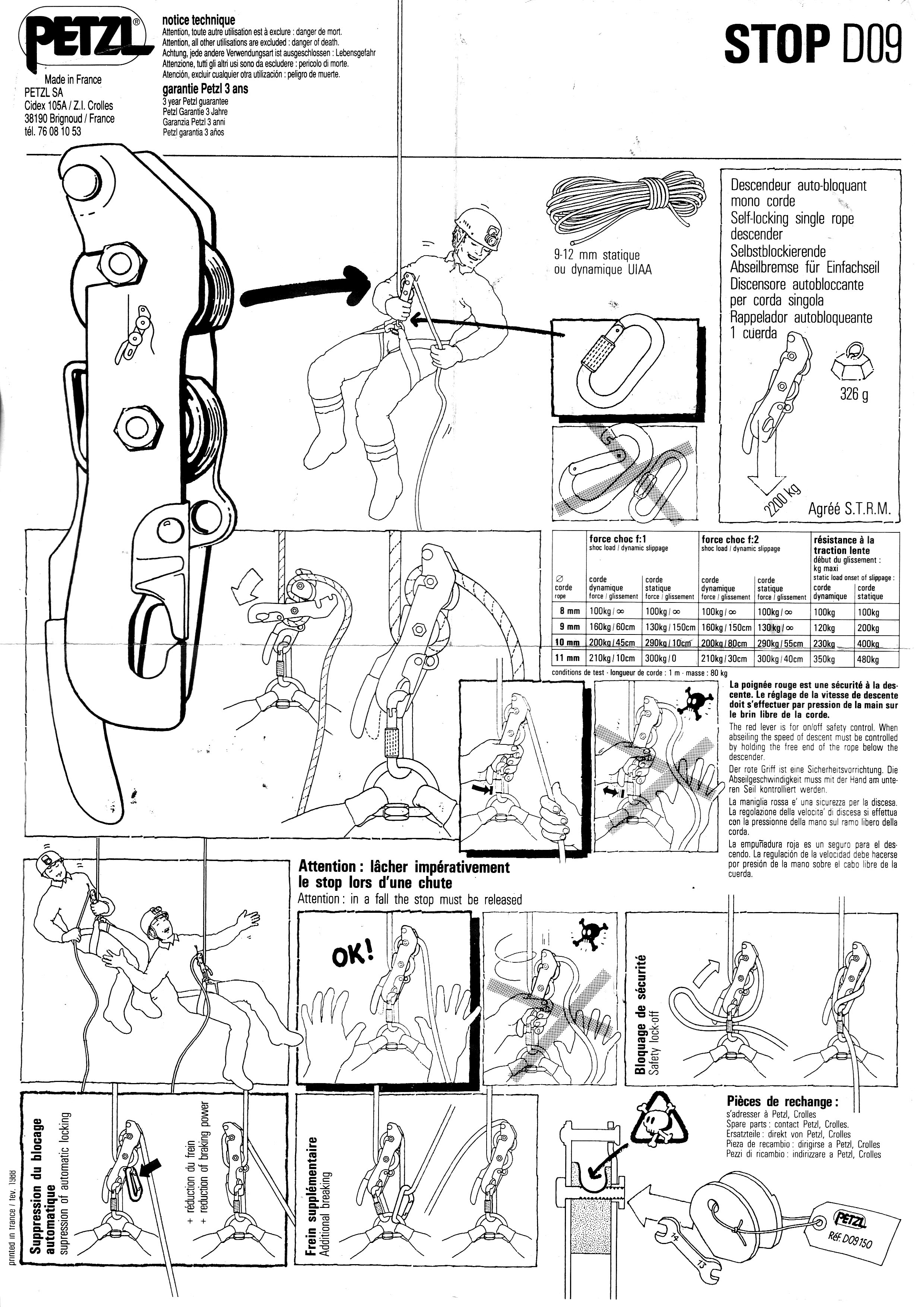 I acquired this descender from Bob & Bob in 1991, and a second, well-used blue one from Avi Basri in 2021.
I acquired this descender from Bob & Bob in 1991, and a second, well-used blue one from Avi Basri in 2021.
This version is 225 mm. tall, 62 mm. wide, 32 mm. thick, and weighs 322 g.
Petzl added some internal ribs to the lower bollard. They also changed the red handle cover, adding corrugations to the outside.
The pivoting side plate is stamped with a rigging illustration, "STOP,"
"BREVETE," "FRANCE_Etranger," the Petzl logo, and "FRANCE." The fixed plate is also stamped
with an illustration of how to rig the bobbin. This diagram is
reversed from the one on the pivoting side plate since one is
looking from the other side. The bollard bolt heads are marked
with "IN-IV" and "A2-70."
The changes do not seem to have any effect the Stop's performance in practice.
[ Top
| Version A
| Version B
| Version C
| Version D
| Version E
| Version F
| Version G
| Version I
| Version J
| Version K
| Return to Bobbins
]
Version H
(#3160)
Technical Details
I acquired this descender from Wade S Walker in 2022
This version is 223 mm. tall, 62 mm. wide, 32 mm. thick, and weighs 327 g.
A tab punched in the pivoting plate limits how far the plate can open for rigging by hitting one of the cam reinforcing ribs.
The pivoting side plate is stamped with a rigging illustration, "STOP,"
"BREVETE," the Petzl logo, and "FRANCE." The fixed plate is stamped
with "95290A" and an illustration of how to rig the bobbin. This diagram is
reversed from the one on the pivoting side plate since one is
looking from the other side. The bollard bolt heads are marked
with "PETZL" and "A2-7 800."
I haven't thought of a good argument for or against the opening stop. It seems like an unnecessary but harmless production expense. Perhaps it makes rigging slightly faster for some people, but I cannot see a difference. The tab and notch may help reduce the chance off a rope coming out of the descender if one foolishly tries rappelling with the pivoting plate open. Seriously, there is no reason to try something that dangerous.
[ Top
| Version A
| Version B
| Version C
| Version D
| Version E
| Version F
| Version G
| Version H
| Version J
| Version K
| Return to Bobbins
]
Version I
(#541)
Technical Details
I acquired this descender from TSA at the International Congress
of Speleology in 1997.
This version is 223 mm. tall, 68 mm. wide, 32 mm. thick, and weighs 325 g.
Petzl finally replaced the stamped gate catch with a plastic
one. It pivots on a steel rivet, and a spring set in a deep slot
closes the gate. With the gate closed, the opening is only 15.8 mm
high. The gate has a widened flat spot on the outside that is
clearly designed to provide a convenient place for one's thumb
to act to open the gate.
There is a slight notch above and to the right of the gate rivet. This helps keep the gate from opening outwards.
The pivoting side plate is stamped with the "Reading
is Dangerous" icon, "CE0197," "STOP,"
"PATENTED," "ROPES O 9≤Ø≤12," an illustration of how to rig the
bobbin, and the Petzl logo. The fixed plate is stamped with
"97133A" and an illustration of how to rig the bobbin.
This diagram is reversed from the one on the pivoting side plate
since one is looking from the other side. There is a rigging icon stamped on the handle. The bollard bolt heads
are marked with "PETZL" and "A2-80." The Petzl
logo is molded into the gate.
This gate design greatly reduces the risk of having the seat
carabiner force the gate open. It also eliminates the corrosion
problem that I've had with the metal gates on some of my other
Petzl bobbins. Overall, I think the new gate may be an improvement,
if it holds up under the abuses inherent in serious caving, but
the wire gate on the Russian Stop Bobbin,
Version B is a worthy alternative.
There is enough reading material stamped on the pivoting side
plate to stave off boredom on long rappels, but please, be safe
and pay attention to the rappel.
[ Top
| Version A
| Version B
| Version C
| Version D
| Version E
| Version F
| Version G
| Version I
| Version K
| Return to Bobbins
]
Version J
(#3026)
Technical Details
I acquired my Petzl Stop, Version J from Joe Nicely in 2021.
Version J is 223 mm. tall, 68 mm. wide, 32 mm. thick, and weighs 323 g.
The pivoting side plate is stamped with the "Reading
is Dangerous" icon, "CE0197," "STOP,"
"PATENTED," "ROPES O 9≤Ø≤12,"
an illustration of how to rig the
bobbin, and the Petzl logo. The fixed plate is stamped with
"04170F" an illustration of how to rig the bobbin, and a round-cornered rectangle containing "EN 341," "ROPE O 910-11mm," "MAX 100m," "MAX 150 kg," and "TYPE A." The bollard bolt heads
are marked with "PETZL" and "A2- 80." The Petzl
logo is molded into the gate. There is a rigging icon stamped on the handle. The inside of the lower cam has "D 09551" cast into it.
Version J adds some more reading material to the back of the descender; otherwise, it is identical to Version I.
[ Top
| Version A
| Version B
| Version C
| Version D
| Version E
| Version F
| Version G
| Version H
| Version I
| Version J
| Return to Bobbins
]
Version K
(#2526)
Technical Details
I acquired this descender from Petzl America in 2019.
This version is 200 mm.
tall, 70 mm.
wide, 38 mm.
thick, and weighs 348 g.
The two main bollards are cast stainless steel. The lower bollard is part of a redesigned autostop assembly. The upper
surface of the bollard is flat and a nose protrudes
at the 10 o'clock position. Friction from the main rope's passage tends to
turn the lower bollard and force the nose towards
the upper bollard, thus locking the rope and ideally arresting
the descent. A plastic
handle is riveted to an extension of the lower bollard at about the seven o'clock position.
The handle is spring-loaded upwards to facilitate carrying. The lower bollard and handle assembly rotate on a shoulder
nut on the lower bolt. A notch on the inside of the handle acts against a pin riveted to the rear side plate, causing the lower bollard to rotate, reducing the clamping action. The rappeller uses the handle to keep the autostop
feature disengaged.
The upper bollard is flattened on its lower side to provide
a flat surface to act as an anvil for the cam action of the autostop
feature. Both bollards have V-shaped rope grooves.
This version incorporates the third auxiliary rod introduced several versions previously.
The pivoting side plate is stamped with a book-with-an-"i" icon, "STOP," an illustration of
how to rig the bobbin, and the Petzl logo.
The fixed plate is printed with "CE0082," "EN15151-2:2012," "Ø8,5-11 mm," "UIAA," "PETZL," "F38920 Crolles cidex 105A," "19E0193580773," and a scanner code. This diagram is reversed from the one on the pivoting
side plate since one is looking from the other side. The fixed
plate is also printed with "06031FE9591." The Petzl logo is molded into the gate.
The revised autostop handle is differs markedly from its predecessors, and anyone making the transition would be wise to spend time to develop new "muscle memory" before using the new version in the field. Here are some of my initial impressions, based in part on my own preferences and physique:
- The autostop feature holds my weight (900 N) securely.
- Releasing the autostop to descend requires pulling down on the handle. I found this to be more awkward than the simple squeezing technique used for earlier versions.
- Like previous versions, the released autostop provides too little friction for my weight and taste. I do not enjoy rappelling with the autostop fully disengaged. "Feathering" the stop feature is not recommended on any stop bobbin. On this one, it seems to provide adequate control, but not as much as some of the earlier versions do.
- Stainless steel bollards should wear better than aluminum alloy bollards, but they are somewhat faster and do not dissipate heat as well.
- This version is 17% larger and 20% heavier than my first Petzl Stop. These are not big differences, but they are noticeable.
- Overall, I prefer some of the earlier versions, but not by any large margin. This version may be better suited for newcomers who do not have to unlearn habits developed from the previous versions.
The eye in the fixed side plate is longer than the one in previous versions. This allows this version to work with the revised Petzl Freino. The newer Freino must be "flipped" through the eye to function properly, and previous versions did not allow enough clearance to do this.
[ Top
| Version A
| Version B
| Version C
| Version D
| Version E
| Version F
| Version G
| Version H
| Version I
| Version J
| Version K
]






